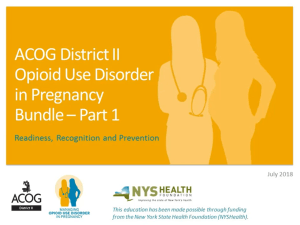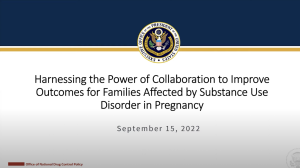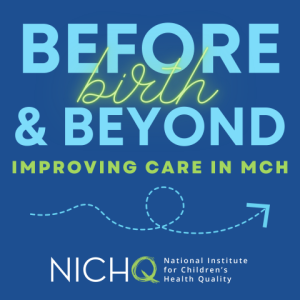National Network of Perinatal Quality Collaboratives (2017 – 2022)
The National Network of Perinatal Quality Collaboratives (NNPQC) provides resources and expertise to nationwide state-based perinatal quality collaboratives (PQCs) with the goal of deepening and accelerating improvement efforts for maternal and infant health outcomes.

Improving perinatal health
The mission of the NNPQC is to support the development and enhance the ability of state perinatal quality collaboratives to make measurable improvements in statewide maternal and infant healthcare and health outcomes.
What is a PQC?
Perinatal Quality Collaboratives (PQCs) are state or multi-state networks of multidisciplinary teams, working to improve outcomes for maternal and infant health. PQCs do that by advancing evidence-informed clinical practices and processes using quality improvement (QI) principles to address gaps in care. PQCs work with clinical teams, experts and stakeholders, including patients and families, to spread best practices, reduce variation and optimize resources to improve perinatal care and outcomes. The goal of PQCs is to achieve improvements in population-level outcomes in maternal and infant health.
PQCs current areas of focus include:
- Reduce preterm births
- Reduce severe pregnancy complications associated with high blood pressure and hemorrhage
- Improve identification of and care for infants with neonatal abstinence syndrome
- Reduce racial/ethnic and geographic disparities
- Reduce cesarean births among low-risk pregnant women
Who
PQCs in 47 states. Thirteen states—Colorado, Delaware, Florida, Georgia, Illinois, Louisiana, Massachusetts, Minnesota, Mississippi, New Jersey, New York, Oregon and Wisconsin—will receive targeted technical assistance as they develop their collaboratives.
Our Role
As the coordinating center, NICHQ will enhance the coordination and communication of PQCs across the nation, advise state PQCs that are in early stages of developing their collaboratives, and give technical assistance focused on quality improvement (QI) methods that improve health outcomes for mothers and newborns.
Funder
This project is funded by the Centers for Disease Control and Prevention (CDC).
Other Information
If you are interested in learning more about this project, email: [email protected]
Project Impact
There are many PQCs that have tackled some complex challenges. Here are a few state examples to provide inspiration that improvement and change is not only possible, but attainable. Full case studies can be found on the CDC website.
Project Impact
There are many PQCs that have tackled some complex challenges. Here are a few state examples to provide inspiration that improvement and change is not only possible, but attainable. Full case studies can be found on the CDC website.
California
Led an initiative to launch a data center to track performance on maternity care service in real-time to support work to reduce severe maternal morbidity and non-medically indicated deliveries before 30 weeks gestation. It resulted in more than 100 hospitals actively submitting data, which provided benchmark statistics comparing hospital performance to county, system, regional and statewide statistics, as well as allowed for analysis at the patient and physician level to identify specific quality improvement opportunities. Read the full case study.
Illinois
Led an initiative to improve the accuracy of birth certificate data. It resulted in improved accuracy on all birth certificate variables from 87 percent at baseline to 97 percent at completion. Read the full case study.
Massachusetts 1
Led a statewide initiative to implement safe sleep practices in all level III neonatal intensive care units. Among eligible infants, overall safe sleep compliance improved from 48 percent to 81 percent; variability across hospital sites was significantly improved, with compliance among hospitals ranging from 9 percent to 91 percent in 2015 and from 64 percent to 97 percent in 2017. This in-hospital quality improvement effort is now expanding to collect post-discharge data on adherence to safe sleep practices in the home. Read the full case study.
Massachusetts 2
Led a statewide initiative among all 10 level III neonatal intensive care units to improve mother’s milk use for very low birth weight infants and to reduce racial/ethnic disparities in mother’s milk use. Over the three-year collaborative from 2015 to 2017, prenatal consultations with human milk education increased from 60 percent to 82 percent and early milk expression within six hours after delivery increased from 40 percent to 60 percent. Overall, >80 percent of very low birth weight infants received mother’s milk a one month and 63 percent at discharge. There was center-to-center variation in racial/ethnic disparities, but overall non-Hispanic whites had the highest rate of any mother’s milk, followed by non-Hispanic blacks, followed by Hispanics. Read the full case study.
New York
Led an initiative to reduce scheduled C-sections and inductions without a medical indication from 36 weeks up to 39 weeks gestation. As a result, Regional Perinatal Centers (RPCs) saw a 97 percent decline in scheduled deliveries without a medical indication between September 2010 and November 2014 and affiliates saw a 94 percent decline in scheduled deliveries without a medical indication between June 2012 and November 2014. Read the full case study.
North Carolina
Led a national initiative to reduce central line-associated bloodstream infections (CLABSI) in neonatal intensive care units (NICUs). It resulted in an almost 60 percent decrease in CLABSI rates in 11 months. The project prevented an estimated 131 infections that translated to an estimated 14 to 41 deaths prevented, and over $2.2 million in excess costs avoided. Read the full case study.
External Resources
CDC PQC Guide
This guide provides states with assistance as they form and develop their PQCs.
Map of PQCs
Discover existing PQCs and contact information or PQC leads.
PQCs in the News
Articles in news outlets covering state PQCs, their activities, and the people that work in the collaboratives.
Related Content
Resources produced by the National Network of Perinatal Quality Collaboratives (2017 – 2022) project or on related topics
Meet Our Team
“In our deep organizational work to move along the Equity Systems Continuum from a Savior-Designed System to an Equity-Empowered System, we acknowledge the power of action. The potential is limitless for today’s commitments to improve the systems in which health care and public health professionals work and families receive care.”





